Magnetic Molecular Imprinted Polymers-Based Nanozyme for Specific Colorimetric Detection of Protocatechuic Acid
Abstract
1. Introduction
2. Materials and Methods
2.1. Chemicals and Instruments
2.2. Preparation of MIPs@Fe3O4-NH2
2.3. Catalytic Colorimetric Properties of MIPs@Fe3O4-NH2
2.4. Adsorption Performance Evaluation
2.4.1. Adsorption Kinetics
2.4.2. Adsorption Thermodynamics
2.5. PCA Detection by Colorimetric Method
2.6. Specificity Test for the Colorimetric Sensor
2.7. Real Sample Analysis
3. Results and Discussion
3.1. Characterization of MIPs@Fe3O4-NH2
3.2. Evaluation of Properties of MIPs@Fe3O4-NH2
3.3. Optimization of Experimental Conditions
3.4. Evaluation of Adsorption Performance
3.5. Construction of Colorimetric Sensors
3.6. Specificity Evaluation
3.7. Real Sample Analysis
4. Conclusions
Supplementary Materials
Author Contributions
Funding
Institutional Review Board Statement
Informed Consent Statement
Data Availability Statement
Conflicts of Interest
References
- Gupta, A.K.; Gurjar, P.S.; Beer, K.; Pongener, A.; Ravi, S.C.; Singh, S.; Verma, A.; Singh, A.; Thakur, M.; Tripathy, S.; et al. A review on valorization of different byproducts of mango (Mangifera indica L.) for functional food and human health. Food Biosci. 2022, 48, 101783. [Google Scholar] [CrossRef]
- Chen, N.; Gao, H.X.; He, Q.; Zeng, W.C. Insight into property, function, and digestion of potato starch modified by phenolic compounds with varying structures. J. Food Sci. 2023, 88, 962–976. [Google Scholar] [CrossRef] [PubMed]
- Masodsai, K.; Lin, Y.Y.; Chaunchaiyakul, R.; Su, C.T.; Lee, S.D.; Yang, A.L. Twelve-week protocatechuic acid administration improves insulin-induced and insulin-like growth factor-1-induced vasorelaxation and antioxidant activities in aging spontaneously hypertensive rats. Nutrients 2019, 11, 699. [Google Scholar] [CrossRef] [PubMed]
- Liu, C.L.; Wang, J.M.; Chu, C.Y.; Cheng, M.T.; Tseng, T.H. In vivo protective effect of protocatechuic acid on tert-butyl hydroperoxide-induced rat hepatotoxicity. Food Chem. Toxicol. 2002, 40, 635–641. [Google Scholar] [CrossRef]
- Hu, J.; Lin, S.; Huang, J.J.; Cheung, P.C.K. Mechanistic study of the in vitro and in vivo inhibitory effects of protocatechuic acid and syringic acid on VEGF-induced angiogenesis. J. Agric. Food Chem. 2018, 66, 6742–6751. [Google Scholar] [CrossRef]
- Safaeian, L.; Emami, R.; Hajhashemi, V.; Haghighatian, Z. Antihypertensive and antioxidant effects of protocatechuic acid in deoxycorticosterone acetate-salt hypertensive rats. Biomed. Pharmacother. 2018, 100, 147–155. [Google Scholar] [CrossRef]
- Rashmi, H.B.; Negi, P.S. Phenolic acids from vegetables: A review on processing stability and health benefits. Food Res. Int. 2020, 136, 109298. [Google Scholar] [CrossRef]
- Rocha, B.A.; Asimakopoulos, A.G.; Honda, M.; da Costa, N.L.; Barbosa, R.M.; Barbosa, F., Jr.; Kannan, K. Advanced data mining approaches in the assessment of urinary concentrations of bisphenols, chlorophenols, parabens and benzophenones in Brazilian children and their association to DNA damage. Environ. Int. 2018, 116, 269–277. [Google Scholar] [CrossRef]
- Song, J.; He, Y.; Luo, C.; Feng, B.; Ran, F.; Xu, H.; Ci, Z.; Xu, R.; Han, L.; Zhang, D. New progress in the pharmacology of protocatechuic acid: A compound ingested in daily foods and herbs frequently and heavily. Pharmacol. Res. 2020, 161, 105109. [Google Scholar] [CrossRef]
- Anwar, H.; Rasul, A.; Iqbal, J.; Ahmad, N.; Imran, A.; Malik, S.A.; Ijaz, F.; Akram, R.; Maqbool, J.; Sajid, F.; et al. Dietary biomolecules as promising regenerative agents for peripheral nerve injury: An emerging nutraceutical-based therapeutic approach. J. Food Biochem. 2021, 45, e13989. [Google Scholar] [CrossRef]
- Xie, A.; Yuan, B.; Lin, J.; Pan, J.; Li, M.; Wang, J.; Jiang, S.; Zhu, S.; Luo, S. Highly sensitive and selective electrochemical sensor based on ZIF-67-derived Co3O4-LaMn0.5Ni0.5O3/MWCNTs for simultaneous detection of protocatechuic acid and ascorbic acid. Surf. Interfaces 2023, 36, 102550. [Google Scholar] [CrossRef]
- Fu, D.; Deng, J.; Zhang, B.; Chen, C.; Lv, C.; Li, H.; Liu, X. Bioenzyme-induced molecularly imprinted polymers using optimal design of computational chemistry for enhanced specific electrochemical sensing of protocatechuic acid in medicines. Sens. Actuators B 2023, 393, 134153. [Google Scholar] [CrossRef]
- Tas-Kucukaydin, M.; Tel-Cayan, G.; Cayan, F.; Kucukaydin, S.; Hazar Ciftci, B.; Ceylan, O.; Emin Duru, M. Chemometric classification of chestnut honeys from different regions in Turkey based on their phenolic compositions and biological activities. Food Chem. 2023, 415, 135727. [Google Scholar] [CrossRef] [PubMed]
- Musa, M.; Wan Ibrahim, W.A.; Mohd Marsin, F.; Abdul Keyon, A.S.; Rashidi Nodeh, H. Graphene-magnetite as adsorbent for magnetic solid phase extraction of 4-hydroxybenzoic acid and 3,4-dihydroxybenzoic acid in stingless bee honey. Food Chem. 2018, 265, 165–172. [Google Scholar] [CrossRef] [PubMed]
- Cheng, J.; Zhou, C.; Xie, Y.; Wang, M.; Zhou, C.; Li, X.; Du, Y.; Lu, F. A new method for simultaneous determination of 14 phenolic acids in agricultural soils by multiwavelength HPLC-PDA analysis. RSC Adv. 2022, 12, 14939–14944. [Google Scholar] [CrossRef] [PubMed]
- Balkrishna, A.; Tomer, M.; Joshi, M.; Gujral, S.; Kumar Mishra, R.; Srivastava, J.; Varshney, A. Standardization and validation of phytometabolites by UHPLC and high-performance thin layer chromatography for rapid quality assessment of ancient ayurvedic medicine, mahayograj guggul. J. Sep. Sci. 2022, 45, 1616–1635. [Google Scholar] [CrossRef] [PubMed]
- Chen, G.; Liu, C.; Li, F.; Zhang, X.; Li, Z. Simultaneous determination of nicotine and phenolic compounds in tobacco by capillary electrophoresis with pipette tip electrodes. Curr. Anal. Chem. 2022, 18, 1029–1036. [Google Scholar] [CrossRef]
- Xu, X.; Qin, X.; Wang, L.; Wang, X.; Lu, J.; Qiu, X.; Zhu, Y. Lanthanide terbium complex: Synthesis, electrochemiluminescence (ECL) performance, and sensing application. Analyst 2019, 144, 2359–2366. [Google Scholar] [CrossRef]
- Yang, W.; Ma, Y.; Sun, H.; Huang, C.; Shen, X. Molecularly imprinted polymers based optical fiber sensors: A review. TrAC Trends Anal. Chem. 2022, 152, 116608. [Google Scholar] [CrossRef]
- Huang, Q.; Zhao, Z.; Nie, D.; Jiang, K.; Guo, W.; Fan, K.; Zhang, Z.; Meng, J.; Wu, Y.; Han, Z. Molecularly imprinted poly(thionine)-based electrochemical sensing platform for fast and selective ultratrace determination of patulin. Anal. Chem. 2019, 91, 4116–4123. [Google Scholar] [CrossRef]
- Haupt, K. Imprinted polymers-tailor-made mimics of antibodies and receptors. Chem. Commun. 2003, 171–178. [Google Scholar] [CrossRef]
- Ostovan, A.; Arabi, M.; Wang, Y.; Li, J.; Li, B.; Wang, X.; Chen, L. Greenificated molecularly imprinted materials for advanced applications. Adv. Mater. 2022, 34, e2203154. [Google Scholar] [CrossRef] [PubMed]
- Cengiz, N.; Guclu, G.; Kelebek, H.; Capanoglu, E.; Selli, S. Application of molecularly imprinted polymers for the detection of volatile and off-odor compounds in food matrices. ACS Omega 2022, 7, 15258–15266. [Google Scholar] [CrossRef] [PubMed]
- Ashley, J.; Shahbazi, M.A.; Kant, K.; Chidambara, V.A.; Wolff, A.; Bang, D.D.; Sun, Y. Molecularly imprinted polymers for sample preparation and biosensing in food analysis: Progress and perspectives. Biosens. Bioelectron. 2017, 91, 606–615. [Google Scholar] [CrossRef] [PubMed]
- Wang, J.; Dai, J.; Xu, Y.; Dai, X.; Zhang, Y.; Shi, W.; Sellergren, B.; Pan, G. Molecularly imprinted fluorescent test strip for direct, rapid, and visual dopamine detection in tiny amount of biofluid. Small 2019, 15, e1803913. [Google Scholar] [CrossRef]
- Yu, M.; Wu, L.; Miao, J.; Wei, W.; Liu, A.; Liu, S. Titanium dioxide and polypyrrole molecularly imprinted polymer nanocomposites based electrochemical sensor for highly selective detection of p-nonylphenol. Anal. Chim. Acta 2019, 1080, 84–94. [Google Scholar] [CrossRef]
- Yang, J.; Hu, Y.; Li, Y. Molecularly imprinted polymer-decorated signal on-off ratiometric electrochemical sensor for selective and robust dopamine detection. Biosens. Bioelectron. 2019, 135, 224–230. [Google Scholar] [CrossRef]
- Zandieh, M.; Liu, J. Nanozymes: Definition, activity, and mechanisms. Adv. Mater. 2023, e2211041. [Google Scholar] [CrossRef]
- Robert, A.; Meunier, B. How to define a nanozyme. ACS Nano 2022, 16, 6956–6959. [Google Scholar] [CrossRef]
- Gao, L.; Zhuang, J.; Nie, L.; Zhang, J.; Zhang, Y.; Gu, N.; Wang, T.; Feng, J.; Yang, D.; Perrett, S.; et al. Intrinsic peroxidase-like activity of ferromagnetic nanoparticles. Nat. Nanotechnol. 2007, 2, 577–583. [Google Scholar] [CrossRef]
- Zhang, Z.; Zhang, X.; Liu, B.; Liu, J. Molecular imprinting on inorganic nanozymes for hundred-fold enzyme specificity. J. Am. Chem. Soc. 2017, 139, 5412–5419. [Google Scholar] [CrossRef] [PubMed]
- Wang, Y.; Yang, X.; Pang, L.; Geng, P.; Mi, F.; Hu, C.; Peng, F.; Guan, M. Application progress of magnetic molecularly imprinted polymers chemical sensors in the detection of biomarkers. Analyst 2022, 147, 571–586. [Google Scholar] [CrossRef] [PubMed]
- Ling, J.; Zhang, W.; Cheng, Z.; Ding, Y. Recyclable magnetic fluorescence sensor based on Fe3O4 and carbon dots for detection and purification of methcathinone in sewage. ACS Appl. Mater. Interfaces. 2022, 14, 3752–3761. [Google Scholar] [CrossRef] [PubMed]
- Li, S.; Pang, E.; Gao, C.; Chang, Q.; Hu, S.; Li, N. Cerium-mediated photooxidation for tuning pH-dependent oxidase-like activity. Chem. Eng. J. 2020, 397, 125471. [Google Scholar] [CrossRef]
- Shen, Y.; Gao, X.; Zhang, Y.; Chen, H.; Ye, Y.; Wu, Y. Polydopamine-based nanozyme with dual-recognition strategy-driven fluorescence-colorimetric dual-mode platform for listeria monocytogenes detection. J. Hazard. Mater. 2022, 439, 129582. [Google Scholar] [CrossRef] [PubMed]
- Chen, Y.; Tang, Y.; Liu, Y.; Zhao, F.; Zeng, B. Kill two birds with one stone: Selective and fast removal and sensitive determination of oxytetracycline using surface molecularly imprinted polymer based on ionic liquid and ATRP polymerization. J. Hazard. Mater. 2022, 434, 128907. [Google Scholar] [CrossRef]
- Nie, F.; Li, C.; Ahmad, N.; Yuan, Z.; Tan, Y.; Xu, Y.; Zhao, C. Molecularly imprinted polymer based on carboxymethylcellulose/graphene oxide composites for selective adsorption of hydroxycamptothecin. ACS Appl. Polym. Mater. 2022, 4, 9294–9304. [Google Scholar] [CrossRef]
- Li, T.; Deng, Z.; Bu, J.; Liu, H.; Yang, Y.; Zhong, S. Quantum dot based molecularly imprinted polymer test strips for fluorescence detection of ferritin. Sens. Actuators B 2022, 358, 131548. [Google Scholar] [CrossRef]
- Kudupoje, M.B.; Vanzant, E.S.; McLeod, K.R.; Yiannikouris, A. Synthesis, evaluation, and characterization of an ergotamine imprinted styrene-based polymer for potential use as an ergot alkaloid selective adsorbent. ACS Omega 2021, 6, 30260–30280. [Google Scholar] [CrossRef]
- Fu, H.; Liu, J.; Xu, W.; Wang, H.; Liao, S.; Chen, G. A new type of magnetic molecular imprinted material combined with beta-cyclodextrin for the selective adsorption of zearalenone. J. Mater. Chem. B 2020, 8, 10966–10976. [Google Scholar] [CrossRef]
- Xiong, J.; Li, Z.; Tan, J.; Ji, S.; Sun, J.; Li, X.; Huo, Y. Two new quinoline-based regenerable fluorescent probes with AIE characteristics for selective recognition of Cu2+ in aqueous solution and test strips. Analyst 2018, 143, 4870–4886. [Google Scholar] [CrossRef] [PubMed]
- Zhu, S.; Yang, Y.; Chen, K.; Su, Z.; Wang, J.; Li, S.; Song, N.; Luo, S.; Xie, A. Novel cubic gravel-like EDAPbCl4@ZIF-67 as electrochemical sensor for the detection of protocatechuic acid. J. Alloys Compd. 2022, 903, 163946. [Google Scholar] [CrossRef]
- Özdokur, K.V.; Koçak, Ç.C. Simultaneous determination of rosmarinic acid and protocatechuic acid at poly(o-phenylenediamine)/Pt nanoparticles modified glassy carbon electrode. Electroanalysis 2019, 31, 2359–2367. [Google Scholar] [CrossRef]
- Xie, L.; Guo, J.; Zhang, Y.; Shi, S. Efficient determination of protocatechuic acid in fruit juices by selective and rapid magnetic molecular imprinted solid phase extraction coupled with HPLC. J. Agric. Food Chem. 2014, 62, 8221–8228. [Google Scholar] [CrossRef]
- Cao, J.; Wei, J.; Tian, K.; Su, H.; Wan, J.; Li, P. Simultaneous determination of seven phenolic acids in three salvia species by capillary zone electrophoresis with beta-cyclodextrin as modifier. J. Sep. Sci. 2014, 37, 3738–3744. [Google Scholar] [CrossRef]
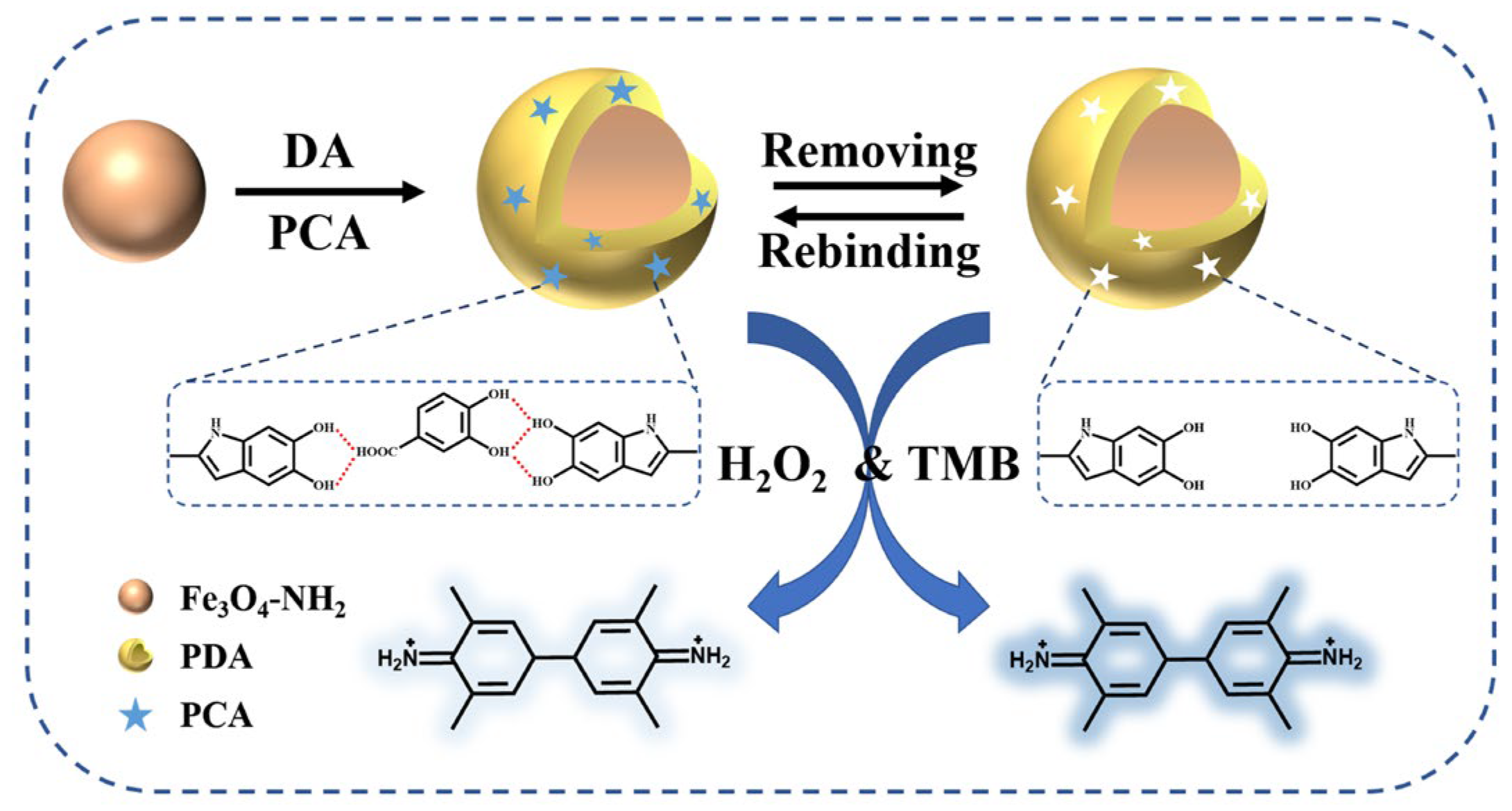
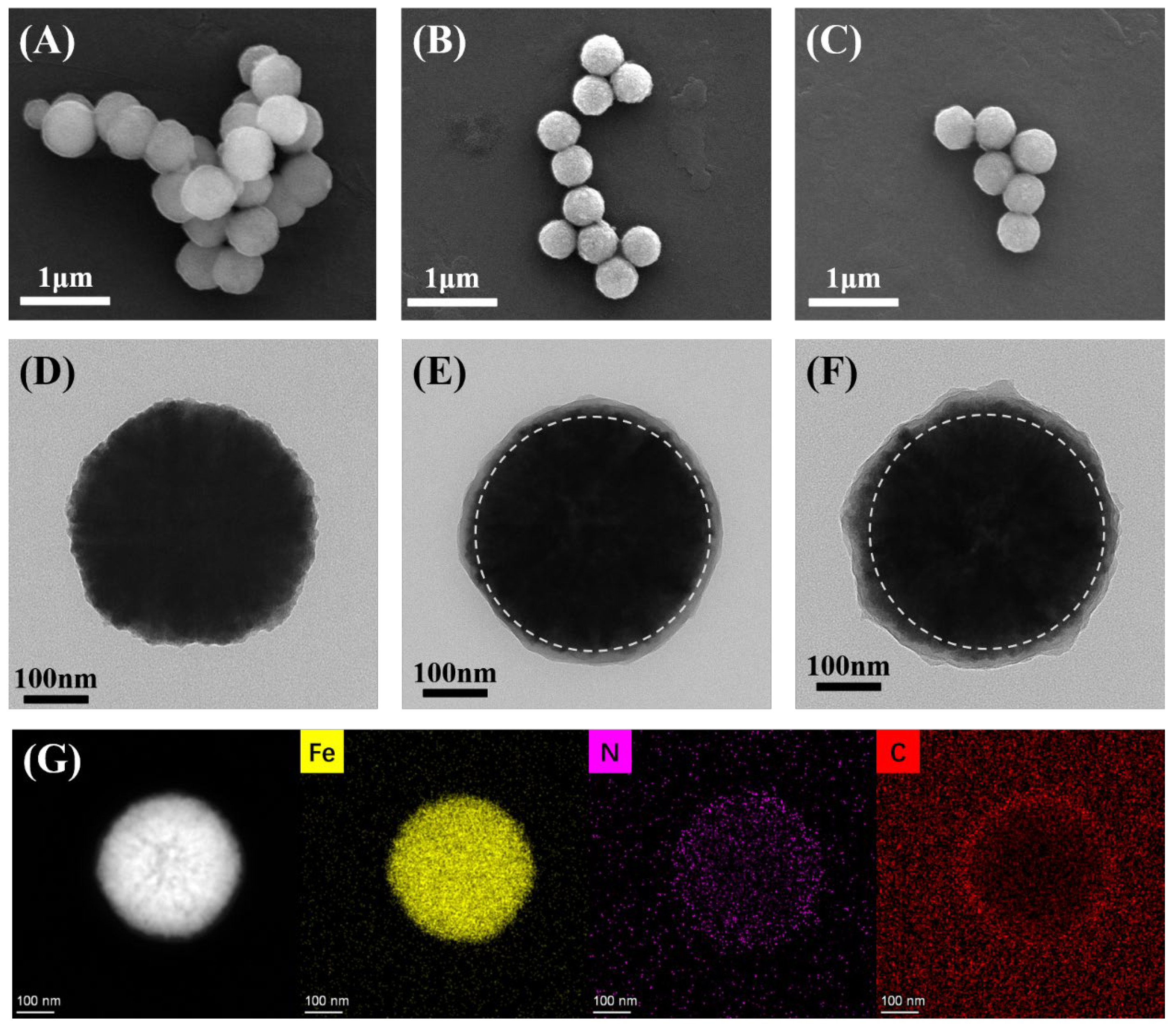
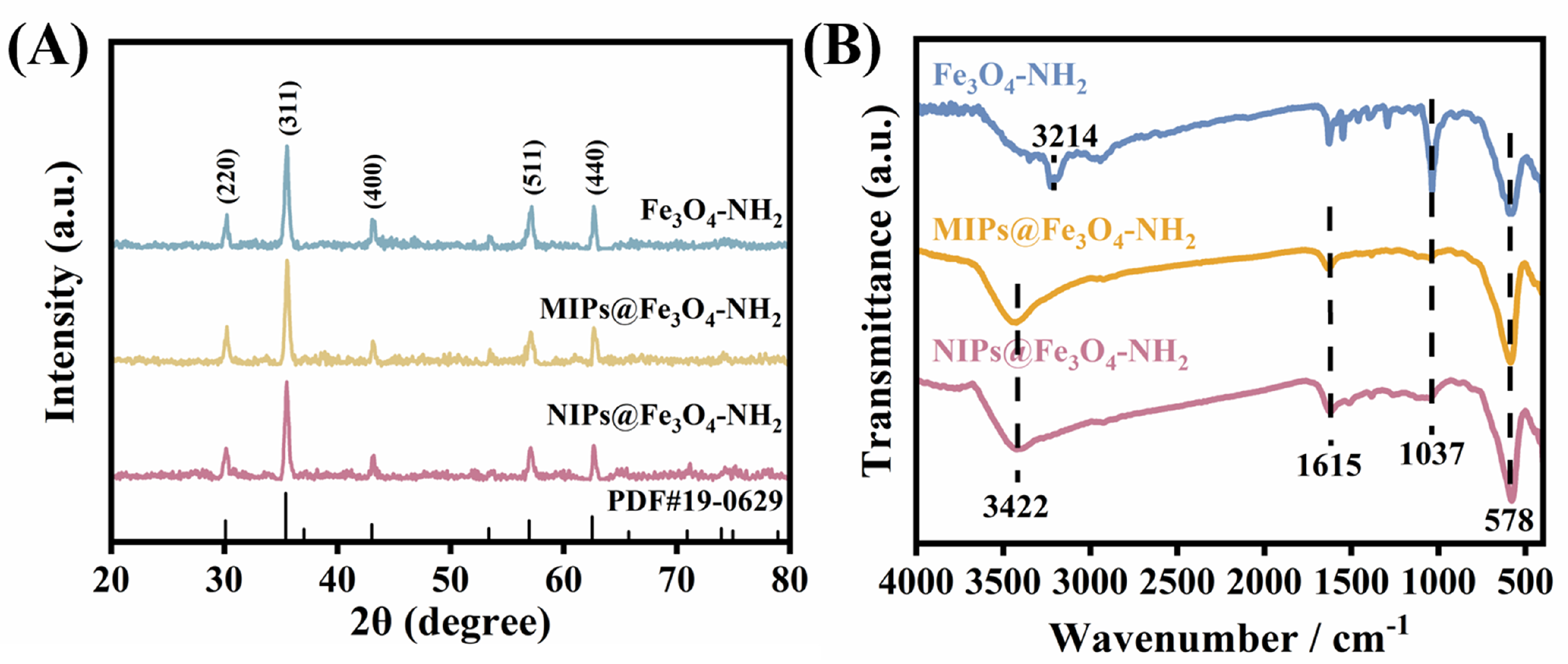
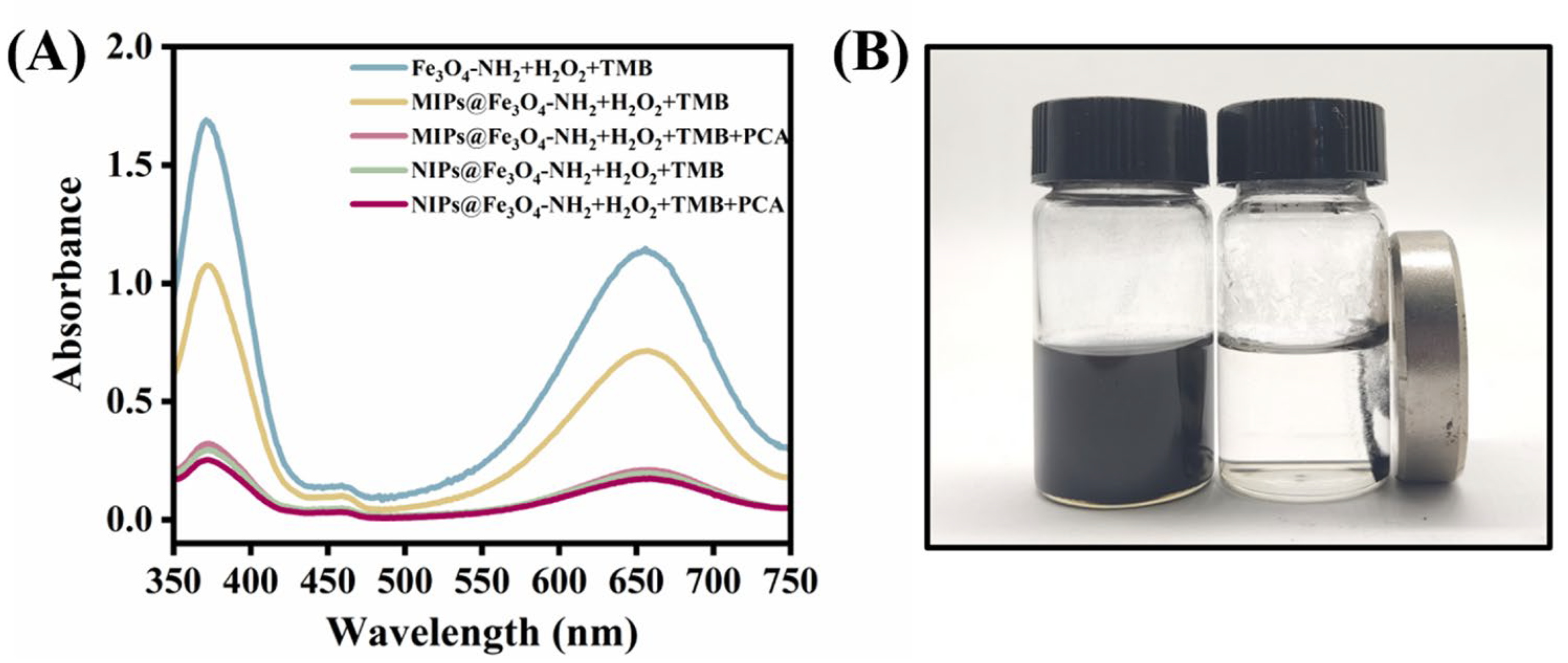
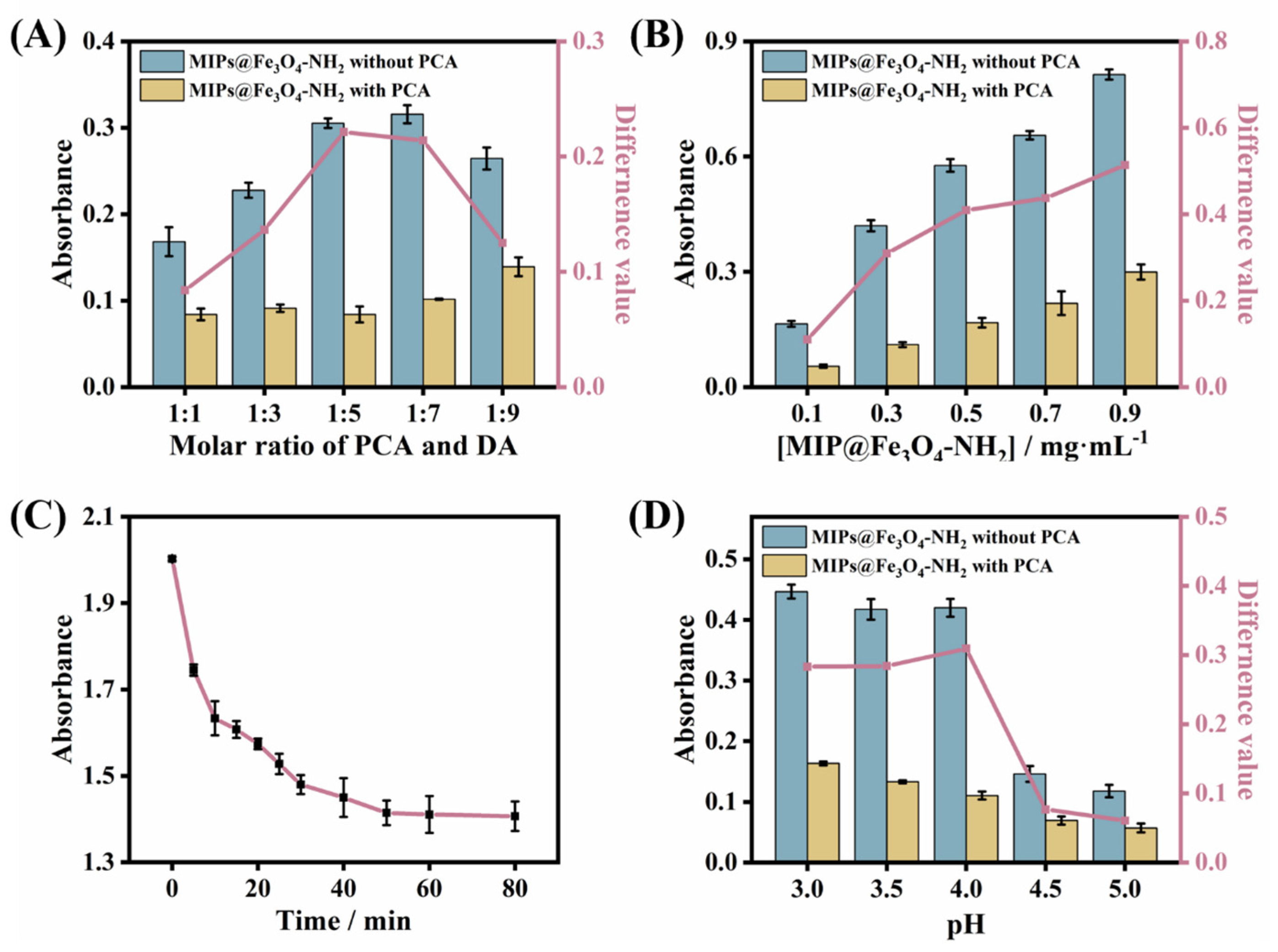

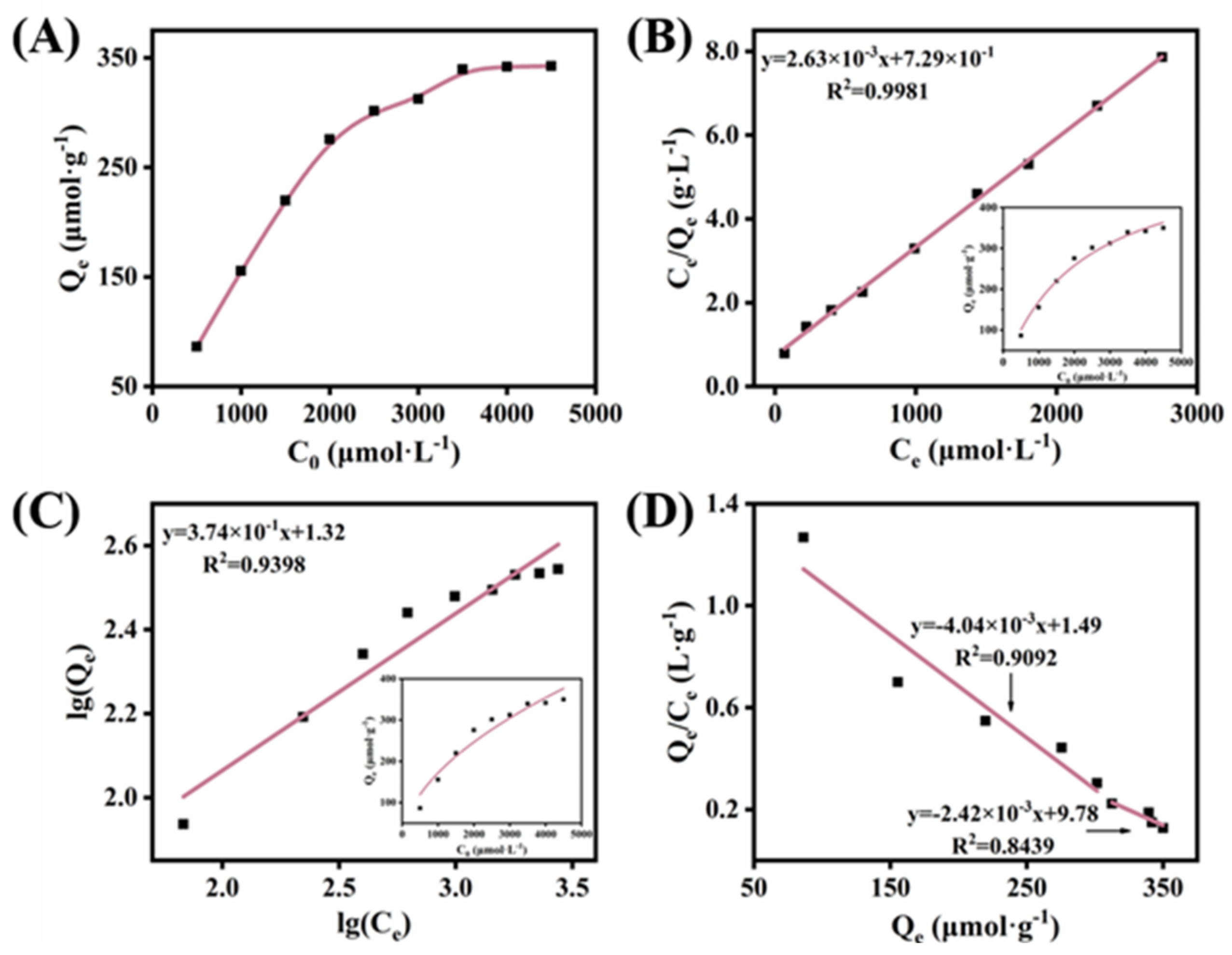
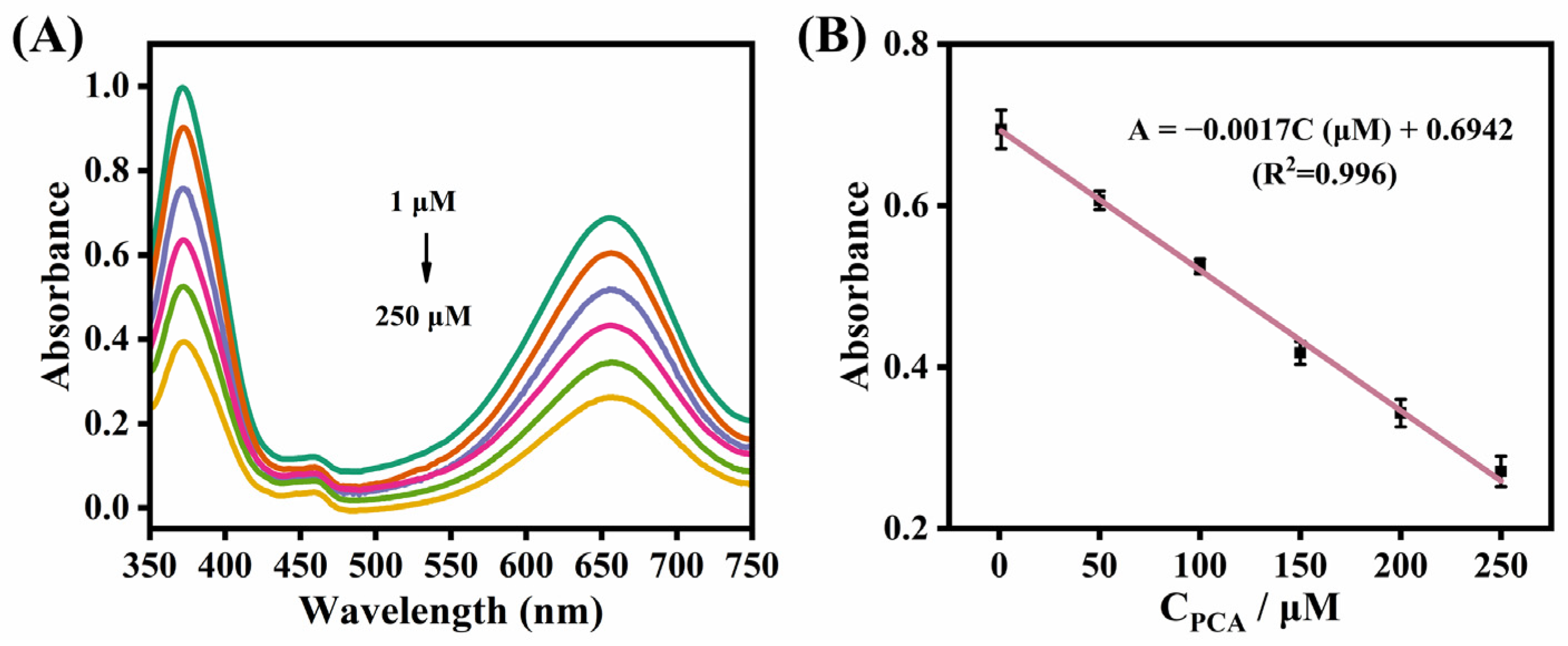
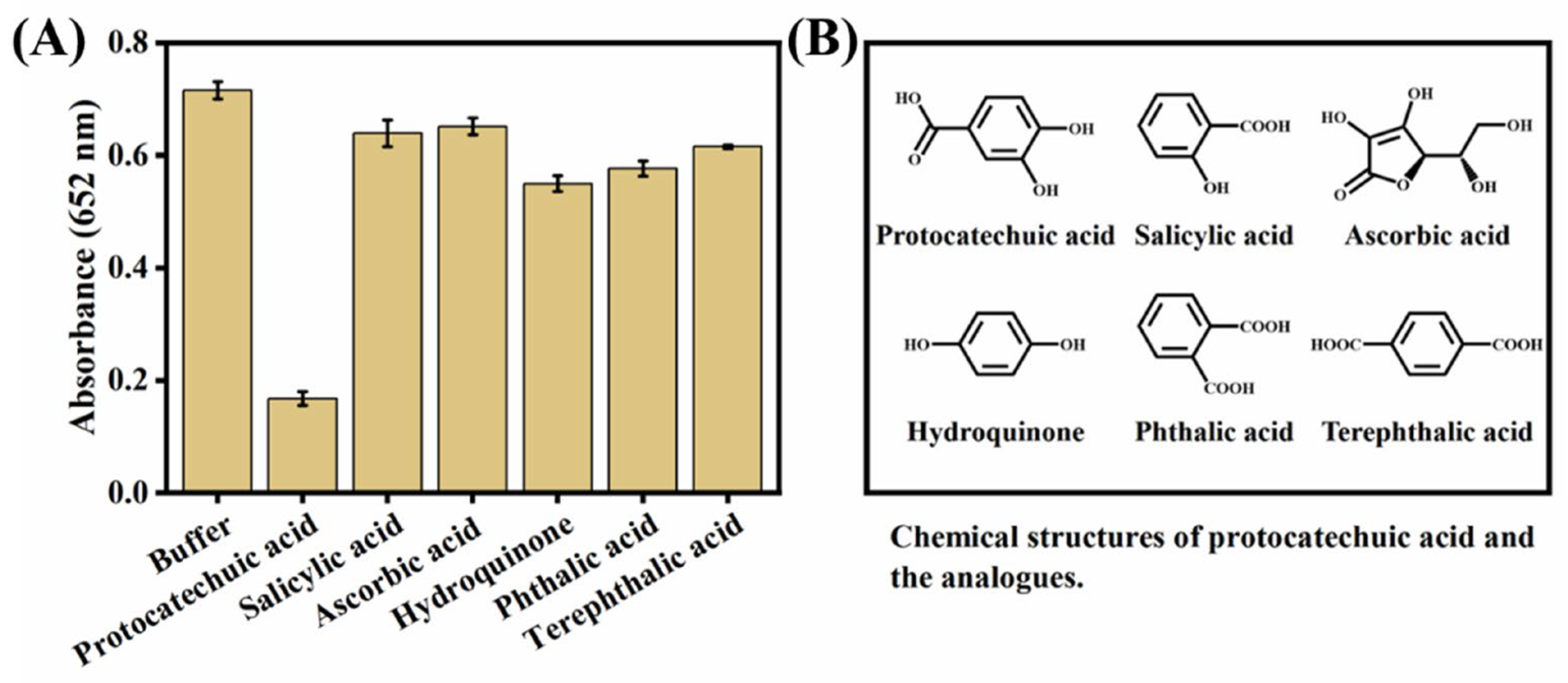
| Methods | Linear Range (M) | LOD (M) | Reference |
|---|---|---|---|
| Electrochemical | 2.20 × 10−5~3.37 × 10−4 | 1.50 × 10−5 | [42] |
| Electrochemical | 1.00 × 10−6~6.00 × 10−5 | 6.00 × 10−7 | [43] |
| HPLC | 6.49 × 10−6~6.49 × 10−4 | 3.24 × 10−6 | [44] |
| Capillary zone electrophoresis | 4.48 × 10−6~3.57 × 10−4 | 1.17 × 10−6 | [45] |
| Colorimetric | 1.00 × 10−6~2.50 × 10−4 | 8.40 × 10−7 | This work |
| Samples | PCA Added (μM) | Found (μM) | Recoveries (%) | RSD (%) |
|---|---|---|---|---|
| Green Tea | 0 | 0.53 | - | 6.19 |
| 50 | 49.43 | 98.86 | 1.63 | |
| 100 | 104.62 | 104.62 | 2.44 | |
| 150 | 152.65 | 101.77 | 1.30 |
Disclaimer/Publisher’s Note: The statements, opinions and data contained in all publications are solely those of the individual author(s) and contributor(s) and not of MDPI and/or the editor(s). MDPI and/or the editor(s) disclaim responsibility for any injury to people or property resulting from any ideas, methods, instructions or products referred to in the content. |
© 2023 by the authors. Licensee MDPI, Basel, Switzerland. This article is an open access article distributed under the terms and conditions of the Creative Commons Attribution (CC BY) license (https://creativecommons.org/licenses/by/4.0/).
Share and Cite
Zhou, Y.; Liu, A.; Li, Y.; Liu, S. Magnetic Molecular Imprinted Polymers-Based Nanozyme for Specific Colorimetric Detection of Protocatechuic Acid. Coatings 2023, 13, 1374. https://doi.org/10.3390/coatings13081374
Zhou Y, Liu A, Li Y, Liu S. Magnetic Molecular Imprinted Polymers-Based Nanozyme for Specific Colorimetric Detection of Protocatechuic Acid. Coatings. 2023; 13(8):1374. https://doi.org/10.3390/coatings13081374
Chicago/Turabian StyleZhou, Yufeng, Anran Liu, Ying Li, and Songqin Liu. 2023. "Magnetic Molecular Imprinted Polymers-Based Nanozyme for Specific Colorimetric Detection of Protocatechuic Acid" Coatings 13, no. 8: 1374. https://doi.org/10.3390/coatings13081374
APA StyleZhou, Y., Liu, A., Li, Y., & Liu, S. (2023). Magnetic Molecular Imprinted Polymers-Based Nanozyme for Specific Colorimetric Detection of Protocatechuic Acid. Coatings, 13(8), 1374. https://doi.org/10.3390/coatings13081374





